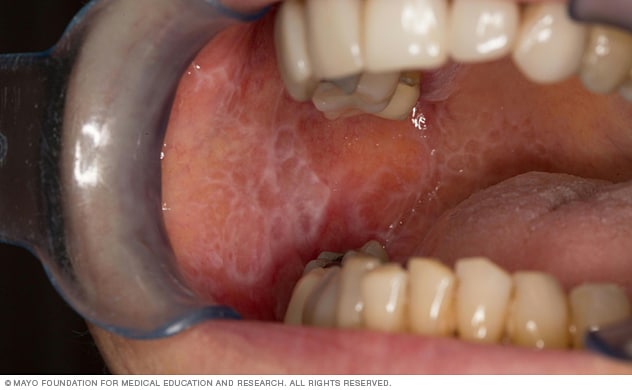Overview
Oral lichen planus

Oral lichen planus
This white, lacelike patch on the interior surface of the cheek is typical for oral lichen planus.
Oral lichen planus (LIE-kun PLAY-nus) is an ongoing inflammatory condition that affects mucous membranes inside the mouth. There are several different types of lichen planus that affect the mouth, but the two main types are:
- Reticular. This type appears as white patches in the mouth and can look lacy. It's the most common type of oral lichen planus. It usually has no related symptoms. And it usually doesn't need treatment or lead to major complications.
- Erosive. This type appears as red, swollen tissues or open sores. It may cause a burning feeling or pain. A healthcare professional should check erosive oral lichen planus regularly because it can lead to mouth cancer.
Oral lichen planus can't be passed from one person to another. The condition occurs when the immune system attacks cells of the oral mucous membranes for reasons that aren't known.
Symptoms usually can be managed. But people who have oral lichen planus need regular checkups. That's because oral lichen planus — especially the erosive type — may raise the risk of getting mouth cancer in the affected areas.
Products & Services
Symptoms
Symptoms of oral lichen planus affect the mucous membranes of the mouth.
Appearance
Signs differ based on the type of oral lichen planus. For example:
- Reticular. This type appears as white patches and can look lacy.
- Erosive. This type appears as red, swollen tissues or open sores.
Location
Signs of the condition may appear on the:
- Inside of the cheeks, the most common location.
- Gums.
- Tongue.
- Inner tissues of the lips.
- Palate.
Pain or other discomfort
The white, lacy patches of reticular oral lichen planus may not cause pain, soreness or other discomfort when they appear on the insides of the cheeks. But symptoms of erosive oral lichen planus that may occur along with red, swollen patches or open sores include:
- Burning sensation or pain.
- Sensitivity to hot, acidic or spicy foods.
- Bleeding and irritation with toothbrushing.
- Inflammation of the gums, also known as gingivitis.
- Painful, thickened patches on the tongue.
- Pain when speaking, chewing or swallowing.
Other types of lichen planus
If you have oral lichen planus, lichen planus may affect other parts of your body, including:
- Skin. Depending on skin color, lichen planus usually appears as purple or violet, flat-topped bumps that are often itchy.
- Genitals. Lichen planus on female genitalia often cause pain or burning and discomfort when having sex. The spots usually are red and eroded. Depending on skin color, sometimes they look like white areas. Lichen planus also can occur on male genitalia.
- Ears. Lichen planus of the ears can lead to hearing loss.
- Nose. Frequent nosebleeds and lasting congestion can occur.
- Scalp. When lichen planus appears on the scalp, it may cause short-term or long-term hair loss. This hair loss could be permanent if not treated.
- Nails. Although rare, lichen planus of the toenails or fingernails may result in ridges on the nails, thinning or splitting of nails, and short-term or long-term nail loss.
- Eyes. Rarely, lichen planus may involve the mucous membrane surfaces of the eyes, possibly causing scarring and blindness.
- Esophagus. Lichen planus of the esophagus is rare. But when it occurs, it may narrow the esophagus or form tight, ringlike bands in the esophagus that can make swallowing hard.
When to see a doctor
See your doctor or other healthcare professional if you have any of the symptoms listed above.
Causes
It's not known what causes oral lichen planus. But T lymphocytes — white blood cells involved in inflammation — appear to be activated in oral lichen planus. This could mean that it's an immune condition and it could involve genetic factors. More research is needed to find the exact cause.
In some people, certain medicines, mouth injury, infection or allergy-causing agents such as dental materials may cause oral lichen planus. Stress may cause symptoms to get worse or come back from time to time. But these causes are not confirmed.
Risk factors
Anyone can get oral lichen planus, but it's more common in middle-aged adults, particularly women over age 50. Some factors may raise your risk of getting oral lichen planus, such as having a condition that lowers your immunity or taking certain medicines. But more research is needed.
Complications
Severe cases of oral lichen planus may raise the risk of:
- A lot of pain.
- Weight loss or not getting enough nutrition.
- Stress or anxiety.
- Depression.
- Scarring from erosive sores or other affected spots.
- Secondary oral yeast or fungal infections.
- Mouth cancer.
Dec. 24, 2024